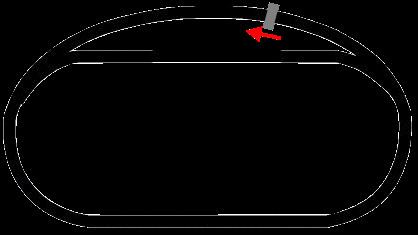Official name Richmond 400 | ||
 | ||
Date February 24, 1980 (1980-February-24) Course Permanent racing facility0.542 mi (0.872 km) Distance 400 laps, 216.8 mi (348.9 km) Weather Chilly with temperatures approaching 66 °F (19 °C); wind speeds up to 8 miles per hour (13 km/h) | ||
The 1980 Richmond 400 was a NASCAR Winston Cup Series racing event that took place on February 24, 1980, at Richmond Fairgrounds Raceway (now Richmond International Raceway) in Richmond, Virginia.
Contents
By 1980, NASCAR had completely stopped tracking the year model of all the vehicles and most teams did not take stock cars to the track under their own power anymore. Only manual transmission vehicles were allowed to participate in this race; a policy that NASCAR has retained to the present day.
Background
In 1953, Richmond International Raceway began hosting the Grand National Series with Lee Petty winning that first race in Richmond. The original track was paved in 1968. In 1988, the track was re-designed into its present D-shaped configuration
The name for the raceway complex was "Strawberry Hill" until the Virginia State Fairgrounds site was bought out in 1999 and renamed the "Richmond International Raceway". The Strawberry Hill Races, which are a series of steeplechase horse races were formerly held the third Saturday of April at the Richmond Raceway Complex. In 2001, the races were moved to Colonial Downs in New Kent County, Virginia's first Thoroughbred racetrack.
Summary
There were 35 American-born male drivers on the grid. Darrell Waltrip defeated Bobby Allison by 1.2 seconds in front of 17,000 people. Nine caution flags were waved for 72 laps along with 19 different lead changes resulted in a race that lasted three hours and twelve minutes.
While Waltrip would earn the pole position with a qualifying speed of 93.695 miles per hour (150.787 km/h) in his #88 Chevrolet Malibu vehicle, the average speed of the actual race was 67.703 miles per hour (108.957 km/h) - a difference of 25.992 miles per hour (41.830 km/h) between the pole position speed and the actual speeds of the race. Baxter Price achieved the last-place finish of the race due to a crash on lap 45 out of the 400 laps being done that day. Richard Childress (racing for himself at Richard Childress Racing) would be the last driver to actually finish the race. He would drive an Oldsmobile as opposed to the Chevrolet vehicles that he would own today.
Tommy Houston would make his NASCAR debut here while Joey Arrington would retire here. Joe Booher would make his best career finish here before dying years later.
